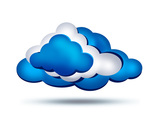Cloud computing – the IT press would have you believe it’s not just the next BIG thing, there’s only Cloud, Cloud and more Cloud on the horizon. And it’s raining down SaaS (Software as a Service) subscription fees.
Yet back in the real world, things, as things are wont to do, work just a bit differently.
Let’s take a quick look at Cloud – as it applies to the SMB market (that’s Small to Medium sized Businesses).
First the press. In a recent column, Forbes Editor Rich Karlgaard delivers a brilliant piece on excelling in both the ‘hard stuff of business’ like Siemens saving millions by moving to cloud computing as well as the ‘soft stuff of business’ which is more on the creative side, customer experience, etc.
Then you can research other cloud articles such as ZDNet’s entire Cloud section, devoted to all things Cloud.
And there’s also Airstream Foods, a grocery distributor located in Long Island, NY – scene of the recent Hurricane Sandy episode that left Airstream’s server room under several feet of water. However, since they’d recently adopted a Cloud strategy, the affected servers were safely humming along, hundreds of miles away in a secure facility.
And while your business may be safely out of the hurricane zone, until Sandy, no one really looked at NY or NJ in the same category as Gulf Coastal Florida or Alabama when it came to hurricane risk – point being, we need preparation for both known, and unknown risk in our IT infrastructure.
Meanwhile, back in the boardrooms of our SMB’s, companies are constantly deciding on whether to adopt SaaS models of software licensing and Cloud models of server deployment.
I’ve been personally involved in probably 30 such decisions in the last three years – 8-10 decided on Cloud, 15 or so went to the standard purchase, owned server model and the rest are still avoiding any decision.
So what are the obvious decision points?
- Breakeven – if we go with SaaS/Cloud it’s huge savings up front, but after about three years it’s a breakeven – we’ll spend about the same on monthly subscriptions as we would have spent to purchase the software and buy new servers.
- Security – regardless of the encryption protocols, some companies are just not comfortable with sensitive company data outside the four walls of the company. This is becoming less of a concern where we’re all doing banking, credit card transactions, and almost everything else online.
- Connectivity – some remote locations can’t rely on 24/7 internet reliability – and even in downtown LA we’re seeing redundant connection protocols able to cut over in a millisecond for mission critical system.
But where should we look? If breakeven is truly about three years, how is Siemens saving millions with Cloud strategies? What’s the buzz really based on?
It’s a combination of factors – but it’s also looking at all the factors in totality.
Let’s take them one at a time:
- Breakeven – yes, SaaS fees and Cloud subscriptions break even after three years – but what about the costs of your onsite server room? What about those guys who help set up your servers, maintain the databases, the network – last we checked, they don’t work cheap and good ones are hard to find. And is it a real breakeven at the end of three years? No. Purchasing means at the end of three years you have software that needs updating (you’ve missed two version updates in the last three years so this will be pricey). And oh, did we mention it’s now 2016, and that SQL Server 2008 you put in a few years ago is WAYYY out of date – and YIKES – that old server you bought years ago won’t run SQL2015.Pro – it’s new server time….looks like our breakeven had a few hidden costs on the ‘purchase’ side of the equation.
- Security – yes it’s comforting to have everything within the building, safe behind our four walls. However, business is happening outside the building. Some studies are showing as much as 60% of the sales process is over before anyone calls your sales department for the first time. Your competitors are taking orders in the customers’ office on smartphones and iPads. The district VP for your biggest competitor just got an alert on his iPhone hours before a huge problem disrupted the entire home office – and he’s in Vegas for a national presentation. In other words, it’s not where your information is housed, it’s where it can be accessed – where it does the most good. Uncomfortable, perhaps. The way the world is now, definitely – manage it with better security, but embrace it.
- Connectivity – again, we’re going to need redundancy – but we’re going to need to connect – to customers, suppliers, our staff – wherever they are, and all the time. We’re going to have to solve this.
Concluding Cloud Musings
There may be reasons – perhaps it’s sales based and our sales force is mobile and would necessarily use the internet to log on – or it’s client facing and all our clients access it from the internet anyway.
But as for breakeven, don’t look for immediate savings on a single application in the Cloud.
However, going forward you should carefully consider whether it makes sense, at the end life of your current equipment, to transfer the entire IT backbone to a Cloud deployment.
So as you make your assessment, make sure you’re capturing all the financial impacts of ownership versus Cloud and get a fuller picture of the savings or cost in your particular environment. It’s worth the time to have a software consultant spend a few days on site performing a full assessment.
Gene Hammons, MBA can be reached at gh@genehammons.com


